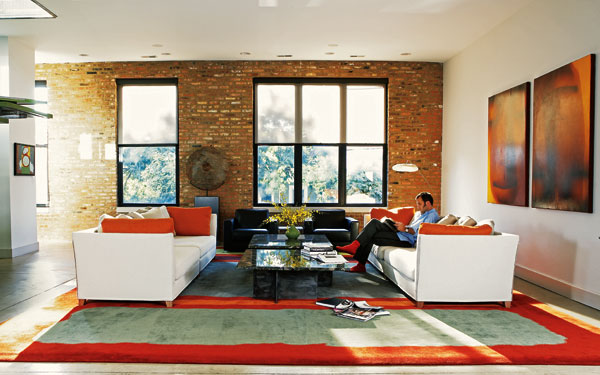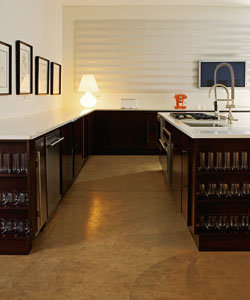
Homeowner Michael Mertz relaxes in his living room. Interior designer Bruce Tittle used his client’s love of color as a starting point when designing the space. Photo Gallery:::
It’s rare to imagine oneself living a certain wonderful way, and then to have that image become reality, right down to the last detail.This fact is not lost on Michael Mertz, who seems genuinely surprised at his luck as he walks around his expansive, 5,000-square-foot Ukrainian Village condo, extolling its many virtues like a little boy with a new train set.
"Before I found this place, I was living in a narrow townhouse near Cabrini-Green-I felt like I was always going up and down the steps. I wanted a space on one level that felt open, but also had pockets surrounding that openness," he says. That townhouse had a small rooftop deck with obstructed views of the skyline; Mertz’s dream was to have a glass house overlooking the city, "so I could feel a part of it, but also have some distance," he explains.
When his real estate agent brought him to a still-unfinished project-a condo conversion of an old streetcar-repair factory-by builder Joseph Panfil of Big Art, it was as if the space, with its wide-open floor plan laid out by Panfil and interior designer Frank Ponterio, had been tailor-made for him.
Almost.

By tucking appliances under the counters, Tittle was able to create a kitchen that didn’t look like a kitchen. The lack of hanging cabinets adds to the open feeling. Photo Gallery::: |
"I asked Joey if we could build a glass enclosure on the roof, and he literally took out a napkin and we started drawing it," says Mertz. The two worked together for months, designing the structure, and later called upon architect Michael Mohr to do the engineering and interior designer Bruce Tittle, whom Mertz has known for years, to complete the picture within the walls.
Mertz (who by day runs a company that helps businesses process credit cards and by night plays bass and sings in a rock band, Pistols at Dawn) is an unabashed party boy. What Tittle brought to the table, in addition to his "incredible sense of how to use color and his ability to just come in and make things look great," says Mertz, was his insight into how Mertz operated.
"Friends come out of the woodwork for Michael," Tittle explains. "And onto the countertops," jokes Mertz’s girlfriend, Marisa Swystun, referring to the fact that parties at Mertz’s are hardly quiet, dignified affairs. Beers are spilled, countertops are used as dance floors, and couches are passed out upon. One must design accordingly.
The concrete floors that Panfil and Ponterio had installed throughout the space were gorgeous-and indestructible-so they stayed. But Tittle suggested that his client opt out of the Carrara marble countertops originally intended for the kitchen in favor of more abuse-resistant Silestone.
You can almost understand why no one thinks twice about dancing on the central island: With all the appliances tucked below the counters and the walls adorned with a collection of John Lennon lithographs and a funky undulating sculpture Tittle designed using panels from Seattle’s Modular Arts, this kitchen looks like a high-class nightclub. It’s a vision of clean design that makes you want to tear out your own upper cabinets and, as Tittle did, boldly put a living room lamp on one of the counters.
As for sofas, Tittle chose low, deep ones and created comfortable lounging areas throughout the space, including one in the master bedroom and several outside, on the rooftop deck, where among the five "rooms" Tittle designed there is one with a decadent sunning bed. He also indulged his client’s completely design-inconsistent whim of having an oak-paneled gentleman’s room filled with English leather furniture. (The third bedroom is used for band practice.)
But the pièce de résistance is Panfil’s glass-enclosed rooftop addition, along with a cream-colored Plexiglas "lighthouse" near the center of the enclosure that Tittle designed to house the bathroom and a bar area. The Plexiglas is trimmed in Macassar ebony wood that continues down one wall to the main level; a steel staircase with green tea-stained ash steps winds alongside it.
As the staircase nears the entry level, it gradually becomes enclosed by dramatic Macassar ebony-covered walls that echo the trim on the lighthouse. "I wanted to make sure that everything with this structure felt unified," says Tittle. "I also knew that because of its location, this staircase would have to be like a work of art."
So it is. When you ascend to the top, to the glass house, you feel the same kind of rush you might feel walking into a happening nightspot. And in a way, when you arrive at Mertz’s, you are doing just that.
For information on resources, see Buyer’s Guide.
Photography: Andreas Larsson
Styling: Arden Nelson
Related:


